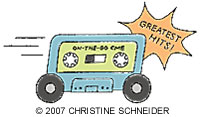
Technology can make your commuting time more productive, but don't underestimate the value of simply watching the trees go by.
Fam Pract Manag. 2007;14(7):56
Dr. Cohen is a family physician in private practice and an adjunct faculty member at St. Peter Family Medicine Residency, Olympia, Wash. Author disclosure: nothing to disclose.

“With the beautiful scenery, how could I get bored commuting?” That was my attitude a few years ago when I began my new job as a family physician in rural Washington state. But after a few months of the 30-minute drive in my 1988 Honda Civic hatchback with the radio cutting out midway, my mantra became “Am I there yet?”
The U.S. Department of Transportation estimates that nearly 120 million Americans commute each day with an average commute time of 26 minutes.1 For me, the daily commute adds up to almost an hour a day of wasted opportunity, whether it's lost financial productivity or a missed chance for personal improvement. So, to break the monotony and increase my productivity during my daily commute, I decided to experiment with multitasking.
My first idea was to try some audio CME. A few companies offer lectures and presentations on tape or CD that you can listen to during the daily grind. I took advantage of a six-month introductory offer to try things out. The tapes (my old Honda still has a cassette player) were of good recording quality and covered many interesting topics, but the audio CME made me feel like I was working an extra hour a day during my commute.
Next, I tried some foreign-language recordings. I had been meaning to brush up on my Spanish, and my local bookstore had a series that focused on medical Spanish. After converting the CDs to tape, I could drive down the highway and any lip readers along the way could watch me say, “Buenos dias, soy el doctor Cohen. Cómo se siente usted?” This worked out well and my skills improved tremendously, but after a few months I had grown tired of listening to the same tapes over and over again.
Still looking for the perfect solution, I polled a few of my colleagues, who suggested audio books on a wide range of topics (available via the Internet, the bookstore or the underutilized public library) and audio podcasts via an MP3 player (e.g., the AAFP News Now podcast, which is available at https://www.aafp.org/news-now/aboutann/podcast.html). Someone even suggested dictating on the go, although this could be a distraction or, if you ride public transportation, it could be the HIPAA violation of all HIPAA violations.
I also observed my fellow commuters for ideas, many of which seemed to come with a heavy downside. For example, we all know that eating in the car isn't a safe or healthy activity, although I do fall into this trap at times. The cell phone is another double-edged sword. Using the hands-free option may be a handy way to return some nonurgent pages at the end of the day or to catch up with an old friend; however, I don't know that my cell phone has ever really improved my quality of life.
For those who live and work in an urban setting, using public transportation could make the commute even more productive, for example, by allowing you to read the newspaper as you travel. In the past, I rode the bus to work and once took the opportunity to socialize with one of my co-commuters. About two years later, I married her. I'd call that a productive use of my commuting time.
Through this journey of figuring out what to do during the trip to and from work, I learned an important lesson. When you finish your CME for the year, become fluent in your foreign language of choice, meet your perfect spouse, and catch up on all your phone calls, sometimes the most productive thing you can do is to sit back, relax and watch the trees go by.